- Features
- Solutions
- Pricing
- Resources
- Contact
- Book a demo
The Ultimate Guide to Designing and Utilizing an Effective Coworking Space Layout
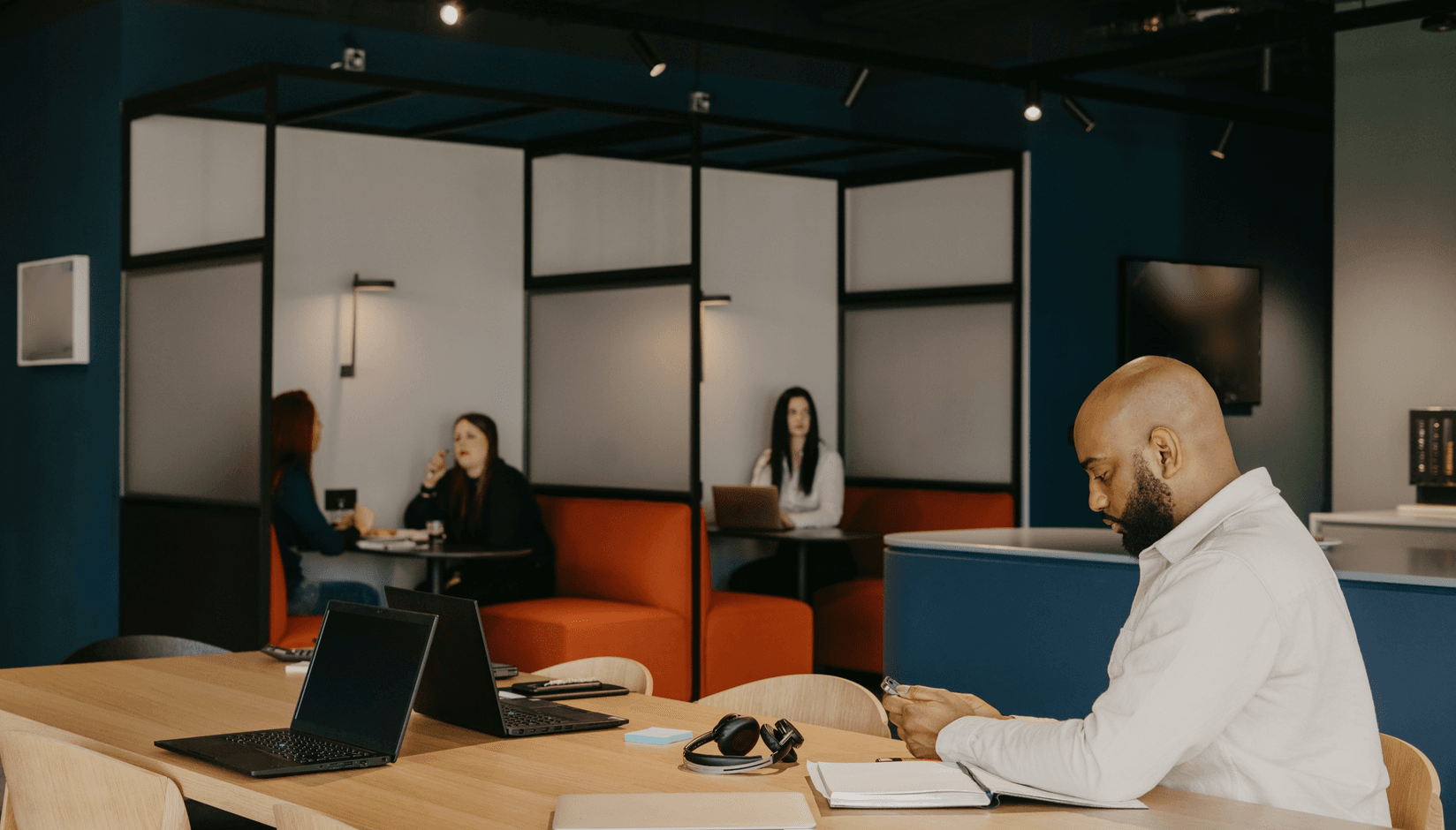
Table of Contents
- How to Design a Coworking Space
- Step 1: Analyzing Current Trends and Future Projections in Coworking Space Design and Usage
- Step 2: Understanding Your Target Audience for Layout Design
- Step 3: Defining and Designing Essential Rooms
- Step 4: Designing for Collaboration and Privacy
- Step 5: Invest in Ergonomics and Comfort
- Step 6: Purchase Tech Infrastructure and Modern Amenities
- Step 7: Create Aesthetics and Promote Branding
- Step 8: Control Safety and Accessibility
- Step 9: Make Changes to Your Design
- Conclusion
- FAQ
Coworking space design is vital. A good design helps people work better and feel good. It lets them focus alone or work well in groups. Creative design sets the mood and makes people feel part of a community. With the right setup and furniture, members feel inspired and ready to do their best work.
Our guide offers actionable tips for creating a flexible layout that caters to diverse needs, setting up collaboration zones that encourage connections, and prioritizing comfort.
We'll also explore the world of tech-forward amenities that keep your members engaged and the power of community building to cultivate a loyal and supportive network of professionals.
How to Design a Coworking Space
Definition and purpose of coworking spaces
Coworking spaces are shared offices where people from different backgrounds work together, collaborate, and network. They're perfect for independent workers, small business owners, and creative thinkers who want a flexible and supportive place to get stuff done while having a good time.
The evolution of coworking spaces
According to Statista, there are currently around 19,000 coworking spaces worldwide, projected to double to 43,000 by 2024 nearly. And get this - experts expect the number of people working in coworking spaces to triple, reaching five million by 2024!
It's so exciting to see how these spaces have evolved into diverse ecosystems, offering so much more than just a place to work.
Side note: Read more about the coworking space concept here: “What Is a Coworking Space?”
Step 1: Analyzing Current Trends and Future Projections in Coworking Space Design and Usage

Current trends in coworking space design
People who fail to plan, plan to fail. Once you implement your coworking office space design idea, it’s difficult to change it. So, you must work on getting it right and researching. Start by looking at successful spaces and things they have in common. Our team picked up on several trends.
- Flexible workspaces: Offering more flexible options for remote workers, freelancers, and part-time users. For example, daily, weekly, or monthly memberships to accommodate diverse work schedules and preferences.
- Modular furniture: Incorporating easily reconfigurable furniture to create adaptable and customizable work areas.
- Biophilic design: Bringing nature indoors by integrating plants, natural materials, and daylight for a refreshing and calming atmosphere.
- Connected technology: Implementing smart office solutions with centralized control for lighting, temperature, and other environmental factors.
- Collaborative spaces: Designing open areas and zones to foster teamwork, creativity, and idea exchange.
- Acoustic design: Focusing on noise reduction and soundproofing to enhance concentration and productivity.
Future projections in coworking space design
Being on top of current trends is great, but truly successful businesses look at the future. In our opinion, customers are more likely to resonate in the future with these trends:
- Wellbeing: Placing greater emphasis on employee health and mental well-being through wellness programs and dedicated spaces.
- Human experience: Creating a positive and engaging workplace experience to attract and retain top talent.
- Coffee culture: Offering high-quality coffee amenities to enhance satisfaction and social interactions.
- Sustainability: Integrating eco-friendly practices and Corporate Social Responsibility (CSR) policies for a greener workplace.
- Technology: Increasing use of AI, smart buildings, and augmented reality to enhance productivity and collaboration.
- Autonomous workstations: Implementing individualized workstations with automated adjustments for personalized comfort.
- Holograms and augmented reality: Revolutionizing communication and collaboration through immersive technologies.
- Biomimicry and bio layering: Integrating nature-inspired solutions for a healthier and more harmonious work environment.
Trends in action in 5 coworking space design examples
At this point, you might wonder how successful coworking spaces implement these trends in practice. If you want to see the theory in action, look at these cases and pay attention to their creative design approach.
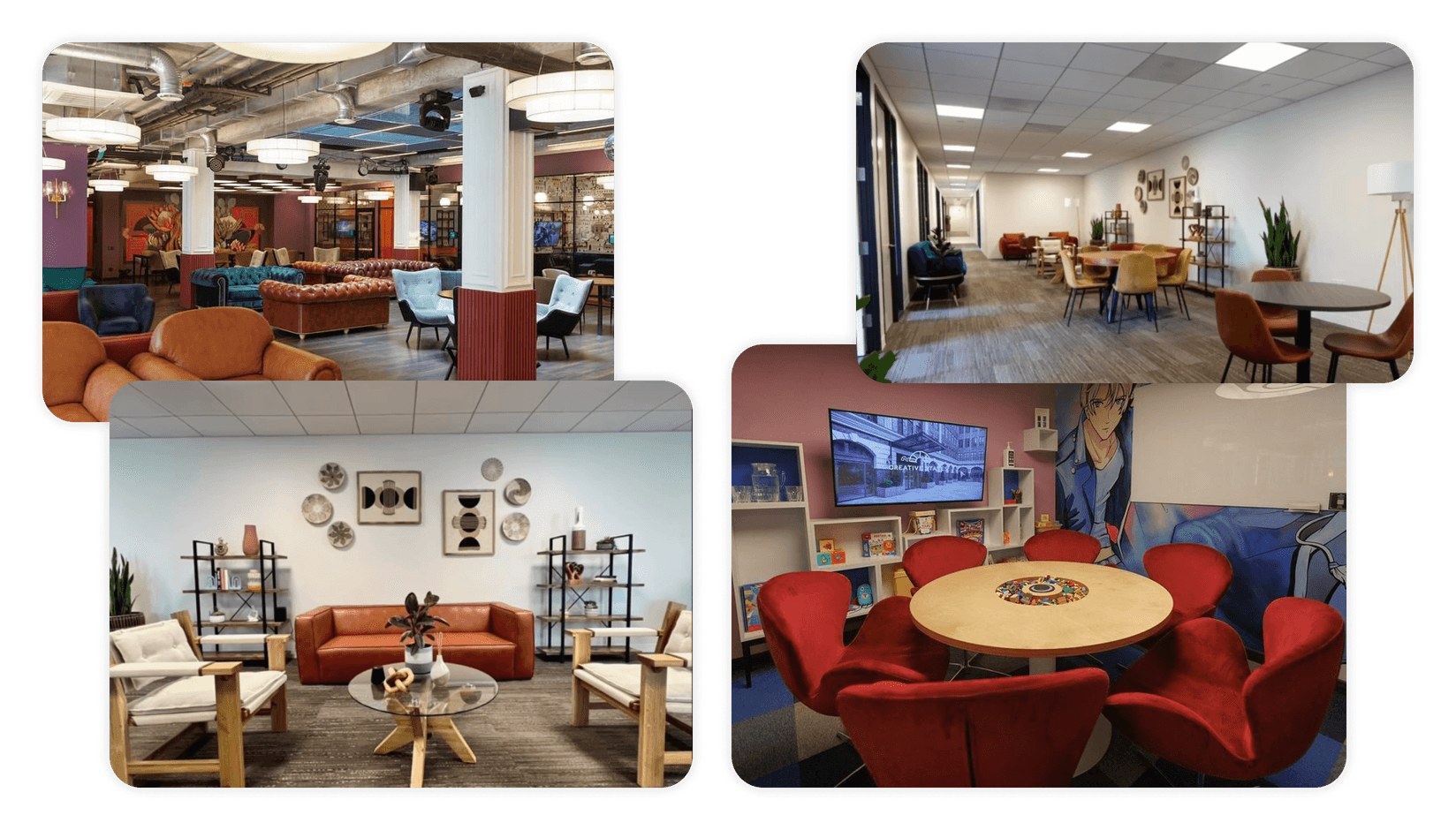
1. Creative States—premium flexible space
Creative States excels at crafting coworking spaces that inspire innovation! Their keen eye for detail is evident, from captivating murals highlighting iconic cities like New Orleans and Los Angeles to thoughtfully curated furnishings and layouts that foster collaboration and productivity.
They seamlessly integrate contemporary office design trends, including biophilic elements such as indoor plants and trees that infuse nature into their spaces. A members' app showcases a commitment to connected technology, making workspace services accessible sans manager assistance. Meeting room displays provide quick distance-based room availability checks.
Embracing a vibrant coffee culture, Creative States offers a wide range of beverages skillfully prepared by professional baristas. With five Kyiv and Dnipro locations in Ukraine, Creative States prioritizes design, ensuring an exceptional coworking experience that adapts to diverse preferences.
2. Village Workspaces—boutique space for creatives
Nestled in Los Angeles, Village Workspaces boasts captivating coworking design, blending aesthetics with member well-being. It's a space that sparks inspiration, thoughtfully crafted for enhanced productivity and triumph.
They're ahead of the curve with modern trends: think connected technology via their members' app, acoustic design for focused ambiance, and autonomous workstations that suit diverse preferences.
But it's not just about work. Enjoy on-tap beer and wine, plus a podcasting studio for creative ventures. Their scientific coworking office space design approach nurtures success and happiness, backed by exceptional hospitality that truly values each member.
3. Lamb—wellness space
At the heart of Stockholm, you'll find LAMB Wellness Workspace – a unique coworking haven where well-being and productivity take center stage. Their entire setup, from design to culture, revolves around boosting members' feel-good factor and unleashing their best work.
LAMB embraces modern trends in tech, well-being, and the human experience. With features like a sauna, meditation room, and yoga classes, they go beyond typical workspaces, fostering healthy habits and balance.
It's more than a workspace; it's a well-being hub. LAMB cares about members, creating a space where work feels refreshing and thriving comes naturally.
4. Cowo & Crèche—child-friendly space
Cowo & Crèche is a unique small boutique coworking space in Alexandria, VA, designed to support working professionals and career parents—again, there's a clear focus on well-being and flexibility. Its on-site nursery/preschool allows parents to focus on work while their little ones are cared for by professional staff members.
The modern and technology-driven space offers easy booking through the app and real-time updates through the Brightwheel app (notice the advanced use of technology, another trend), ensuring peace of mind for parents during work hours. Shamena Nurse-Kingsley's innovative concept strikes the perfect balance between work and childcare needs, making it a game-changer for working parents like herself.
5. Ìpàdé
Ìpàdé coworking space is a gathering place that celebrates culture and community. Its name, "coming together" in Yoruba, reflects its mission to provide a welcoming environment for black women and women of color.
This small coworking space's vibrant and colorful design draws inspiration from African and diasporic aesthetics, creating an environment that feels like home—a comforting and empowering embrace. Human experience, a huge trend in the market, is the focus of this booming space. Adorned with artwork by black women and women from the African diaspora, Ìpàdé curates books, candles, and affirmation items that celebrate the brilliance and power of black women.
Step 2: Understanding Your Target Audience for Layout Design
Know your audience before you plan your coworking office space layout. Find out who will use your space. This helps make a good design. Design your space for your members' needs — this makes them happy and keeps them coming back.
Types of coworking space users and their unique needs
Let's explore how different users, from corporate clients to freelancers and digital nomads, each have their own needs and ideas that shape the vibrant tapestry of coworking office space design.
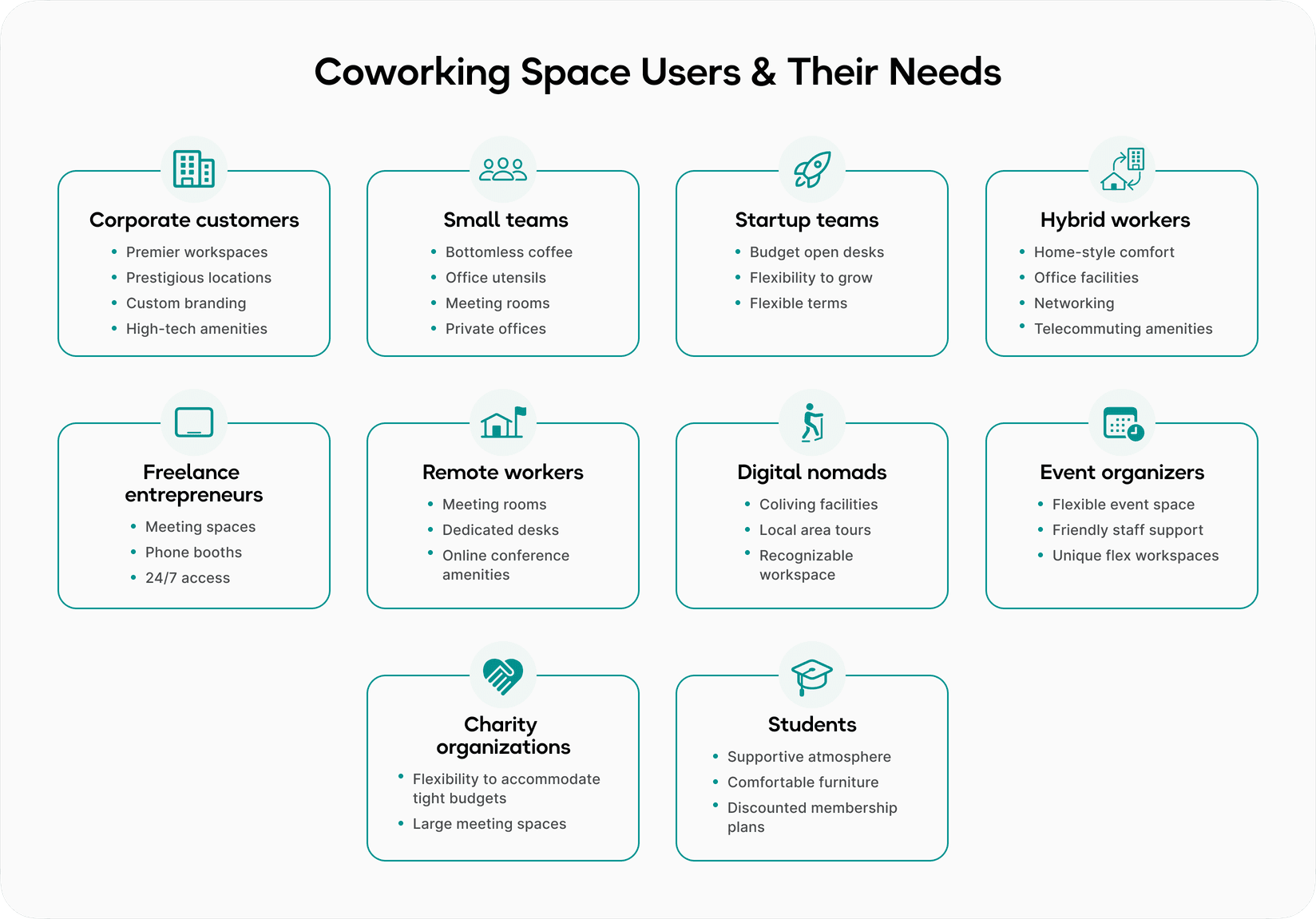
1. Corporate customers
- Premier workspaces and prestigious office locations.
- Custom branding and larger private offices.
- High-tech amenities like meeting room booking systems and cloud printing.
2. Small teams
- Free bottomless coffee and access to office utensils.
- Conference/meeting rooms and private office spaces.
- Convenient location with a nice cafe or restaurant nearby.
3. Startup teams
- Budget-friendly open desks to accommodate growth.
- Readiness to cater to growing requirements and team suits.
- Flexible terms to support their uncertain business trajectory.
4. Hybrid workers
- A combination of home-style comfort and traditional office facilities.
- Opportunities for networking and communication to fight solitude.
- Rooms and technology for seamless online conferences.
5. Freelance entrepreneurs
- Decent meeting spaces and phone booths for client communication.
- 24/7 access to the workspace for productive and timely work.
6. Remote workers
- Dedicated desks.
- Solutions for online conferences and strict security requirements.
- Access to quiet or private spaces for frequent video calls.
- Small meeting rooms that can be booked multiple times a day.
7. Digital nomads & people on workation
- Coliving facilities and activities to explore the local area.
- Instagram-worthy spaces with photo-worthy designs and branded coffee cups.
- A mix of quiet and vibrant areas to accommodate their versatile work styles.
8. Event organizers
- Flexible event space for hosting events.
- Friendly staff support.
9. Charity & non-profit organizations
- Flexibility to accommodate tight budgets and changing space needs.
- Larger meeting spaces for meetings, training, and events.
10. Students & interns
- The supportive atmosphere with comfortable furniture and amenities.
- Discounted or sponsored membership plans.
- Study-friendly environment with large whiteboards and abundant coffee.
Step 3: Defining and Designing Essential Rooms
Common types of rooms/spaces in coworking environments and their purposes
For coworking space owners, the art lies in curating environments that cater to diverse needs. Here's a breakdown of the various room types your space can offer, each serving a unique purpose to enhance the experience for your members.
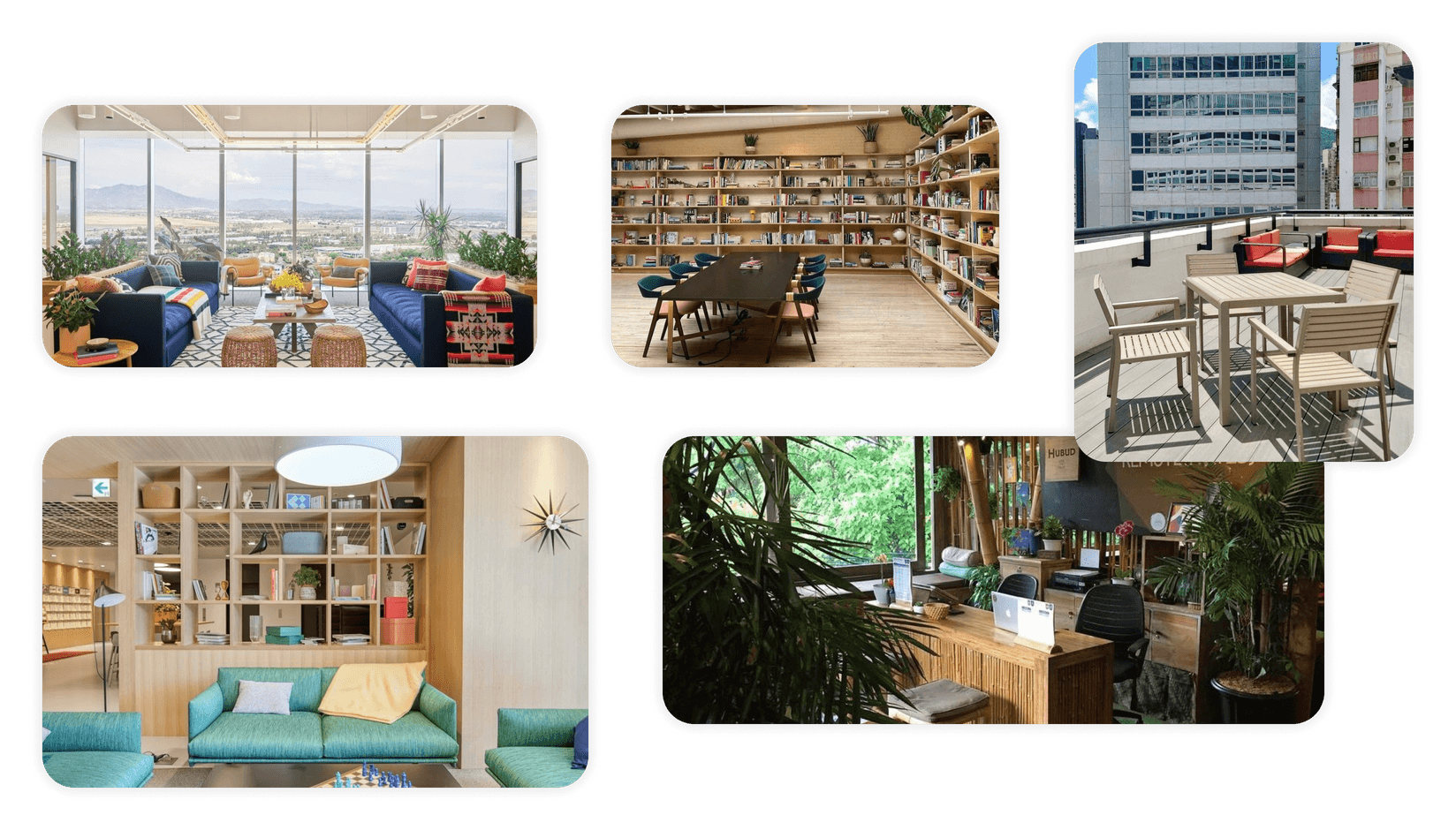
- Private offices: Private offices offer a secluded and focused work environment for individuals or small teams. They provide privacy for sensitive discussions and concentrated tasks.
- Meeting rooms: Meeting rooms are essential for hosting client meetings, team collaborations, or video conferences. They facilitate professional discussions and presentations.
- Podcast rooms: Podcast rooms cater to content creators and podcasters, offering a soundproof space with quality recording equipment for high-quality audio production.
- Photo studios: Photo studios are equipped with professional lighting and backdrops, ideal for photographers and content creators who need dedicated spaces for photo shoots.
- Conference/event spaces: These multipurpose areas accommodate workshops, seminars, and networking events, promoting community engagement and collaboration.
- Lounge: Purpose: The lounge area is a comfortable and inviting space for relaxation, informal meetings, and social interactions among members.
- Kitchen and break rooms: Kitchen and break rooms provide members with a place to prepare meals, enjoy snacks, and take breaks from work, fostering a sense of camaraderie and well-being.
- Fitness center: A fitness center promotes a healthy and active lifestyle, allowing members to exercise conveniently without leaving the coworking space.
- Warehouse: For businesses that require storage solutions, warehouse services within the coworking space offer a convenient option to store inventory and supplies.
- Production spaces: Production spaces cater to creative professionals and makers, offering well-equipped areas for design, crafting, and prototyping.
- Restrooms and showers: Restrooms and showers are essential amenities that ensure members' comfort and convenience, especially for those who cycle or exercise during their workday.
- Nap rooms: Nap rooms offer a quiet and peaceful space for members to take short power naps, boosting productivity and overall well-being.
- Lactation rooms: Lactation rooms are dedicated spaces for nursing mothers to pump or breastfeed comfortably and privately.
- Phone booths: Phone booths provide soundproof areas for members to make private calls, ensuring confidentiality and minimizing disturbances in shared spaces.
- Meditation or quiet rooms: Meditation or quiet rooms create serene environments for members seeking solitude or relaxation during a busy workday.
- Printing rooms: Printing rooms have high-quality printers, scanners, and other printing facilities. They provide a dedicated space for members to conveniently print documents, brochures, or marketing materials within the coworking space.
Factors to consider when deciding which types of rooms to include in your coworking space
When designing your small or big coworking space's room offerings, keep these key factors in mind to ensure you create an environment that caters to your members' needs:
- Member demands: Consider the needs and preferences of your target audience. Survey your members to understand which types of rooms they require most for their work or projects.
- Flexibility and adaptability: Opt for multi-functional spaces that you can easily reconfigure. This ensures you can cater to various user demands and adjust the rooms as your member base evolves.
- Local market trends: Research the local market to identify popular room types in demand. Stay updated on emerging trends and incorporate them to stay competitive.
- Budget and space constraints: Assess your budget and available space to determine feasible rooms. Prioritize essential rooms that align with your target audience's needs.
- Diverse professional services: Consider the mix of professionals you aim to attract. If your space caters to a specific industry, offer rooms that cater to their unique requirements (e.g., video editing suites for multimedia professionals).
- Member growth potential: Plan for future member growth and anticipate their evolving needs. Invest in room types that can accommodate increasing demand and support member expansion.
Step 4: Designing for Collaboration and Privacy
The role of design in promoting collaboration among users
Strategic layout, furniture selection, and overall ambiance can encourage organic interactions and idea exchange. To promote collaboration, consider the following coworking office space design ideas and strategies:
- Open and inviting spaces: Create open and inviting common areas with comfortable seating, encouraging members to connect and share insights naturally.
- Collaborative zones: Designate specific areas with whiteboards and interactive tools for brainstorming sessions and group work, inspiring creativity and collaboration.
- Community event venues: Incorporate thoughtfully designed community event venues within your coworking space to create vibrant gatherings that unite members, offer networking opportunities, and inspire idea-sharing.
Strategies for providing privacy within an open coworking space
Ensuring privacy in an open coworking space is essential for a productive and harmonious environment. To achieve this, follow these straightforward and casual strategies.
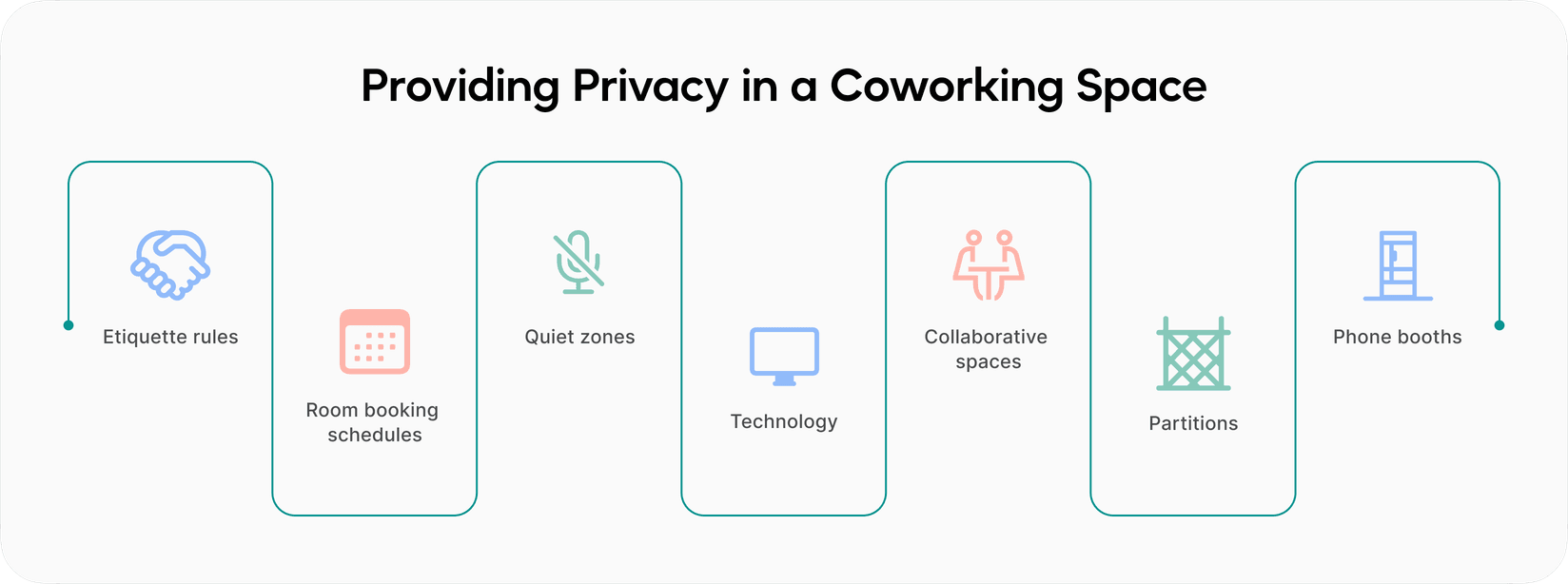
- Set clear etiquette rules
- Keep noise levels low. Use headphones during calls and meetings.
- Respect others' personal space and belongings.
- Stick to room booking schedules and avoid hogging quiet areas.
- Use partitions for privacy
- Install soundproof booths or phone rooms for private calls and focused work.
- Consider movable dividers to create semi-private workstations that encourage interaction.
- Designate quiet zones
- Create specific quiet zones for members who prefer solitude and need to concentrate.
- Introduce private collaborative workspaces
- Establish separate areas for members to communicate, network, and work together.
- Use elevated tables for meetings and brainstorming sessions.
- Install phone booths
- Set up phone booths with VoIP technology for noise-free calls and video conferencing.
- Equip with the necessary technology
- Provide individual charging outlets at desks to minimize distractions.
- Invest in coworking space software for efficient membership management and booking.
Types of collaboration and private areas
To foster collaboration and cater to private needs, consider these options:
Collaboration areas
- Lounge areas: Casual and relaxed spaces that encourage impromptu conversations, networking, and spontaneous collaborations among members.
- Collaborative workspaces: Designated areas with shared desks and whiteboards, creating an environment for members to collaborate on projects, brainstorm ideas, and foster teamwork.
- Open common areas: Open and inviting spaces with comfortable seating that encourage members to connect, share insights, and interact naturally, promoting organic collaborations.
- Community event venues: Thoughtfully designed venues within the coworking space for hosting community events, workshops, seminars, and networking gatherings that unite members and inspire idea-sharing.
Private areas
- Soundproof booths: These private phone booths are perfect for making confidential calls or focusing on tasks without disruptions in an open coworking space.
- Meeting rooms: With presentation tools and comfortable seating, meeting rooms offer a professional setting for team gatherings, client meetings, or private discussions.
- Quiet pods: Small enclosed spaces designed for solitude and focus provide uninterrupted work time for members needing concentration.
- Offices: Private offices offer individual workspaces for teams or individuals who require complete privacy and a dedicated area for their tasks.
- Phone booths: Specially designed for VoIP calls, these booths ensure members have a private space for video conferences and phone conversations.
Step 5: Invest in Ergonomics and Comfort
In coworking office space design, ergonomics means creating a workspace that fits human needs. It minimizes fatigue and discomfort, promoting better performance. By setting up tools and furniture correctly, we prevent injuries.
The importance of ergonomics lies in ensuring comfort for members. It improves posture, reduces fatigue, and prevents injuries. When people feel good physically, they are more productive and engaged. Ergonomic furniture boosts morale and reduces stress in the coworking space. It's all about a workspace that supports well-being and productivity.
Tips for ensuring comfort
- Quality furniture: Invest in high-quality, ergonomic furniture that supports good posture and comfort. Ergonomic chairs with adjustable features and supportive lumbar support are essential for extended work sessions.
- Adjustable desks: Provide height-adjustable desks that allow members to switch between sitting and standing positions. This promotes better blood circulation, reduces strain on the body, and increases energy levels.
- Good lighting: Ensure ample natural light and supplement it with appropriate artificial lighting. Well-lit spaces reduce eye strain and create a pleasant working environment.
- Adequate space: Optimize space planning for comfortable movement and workspace customization. Adequate legroom and sufficient workspace promote flexibility and personalization.
- Encourage healthy posture: Promote regular daily breaks and movement. Display signs or posters with tips on correct sitting posture and remind members to take frequent breaks from their screens.
- Provide ergonomic training: Train members on how to use their equipment correctly and maintain a healthy posture. This can help reduce the risk of injuries.
- Regularly assess the workplace: Conduct regular assessments to identify hazards that could cause injury or discomfort, such as poor lighting, uneven floors, or lack of ventilation.
Health and productivity benefits of ergonomic design
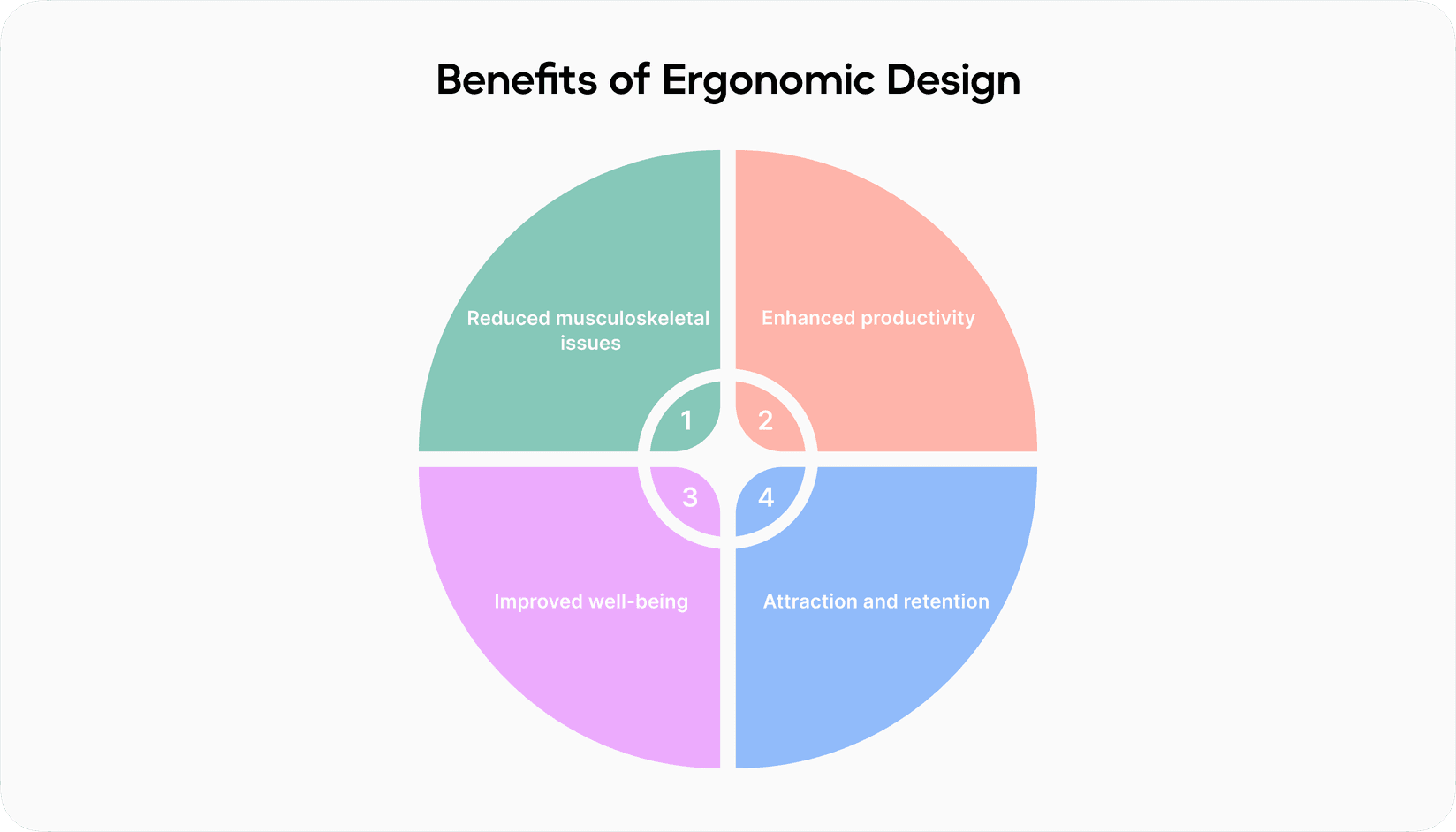
- Reduced musculoskeletal issues: Ergonomic furniture and setups minimize the risk of musculoskeletal problems like back pain, neck strain, and repetitive strain injuries, leading to healthier and happier members.
- Enhanced productivity: Comfortable workspaces improve focus and concentration, enabling members to work efficiently and productively for longer durations.
- Improved well-being: Ergonomic coworking office space design promotes better physical health, positively impacting mental well-being and overall job satisfaction.
- Attraction and retention: Offering ergonomic features demonstrates a commitment to member welfare, making your coworking space more appealing and contributing to member retention.
Step 6: Purchase Tech Infrastructure and Modern Amenities
Robust tech infrastructure
A coworking space's success heavily relies on having a robust tech infrastructure that meets the demands of modern professionals. Key elements include.
- WiFi connectivity: Reliable high-speed internet is a non-negotiable requirement for coworking spaces. Members need seamless connectivity to conduct their work efficiently, collaborate with others, and stay connected with clients and colleagues.
- Power outlets: Ample power outlets strategically placed throughout the workspace are essential. They allow members to charge their devices without hassle, ensuring productivity runs smoothly due to low battery levels.
- AV equipment: Coworking spaces often host meetings, presentations, and workshops. Audiovisual equipment such as projectors, screens, and sound systems enhance the space's versatility and foster a dynamic work environment.
Offer essential amenities
Modern amenities are crucial in attracting and retaining coworking members, enhancing their overall experience. Here are some amenities that add value to the coworking office space design.
- Kitchen: A well-equipped kitchen is more than just a place to prepare meals. It is a social hub where members can bond over shared lunches and foster community.
- Coffee machines: Quality coffee machines are necessary for any coworking space. They energize members throughout the day and create opportunities for casual networking during coffee breaks.
- Recreational areas: Incorporating recreational areas, such as lounge spaces and game rooms, provides a break from work-related stress and encourages relaxation and social interaction among members.
Set up meeting room displays
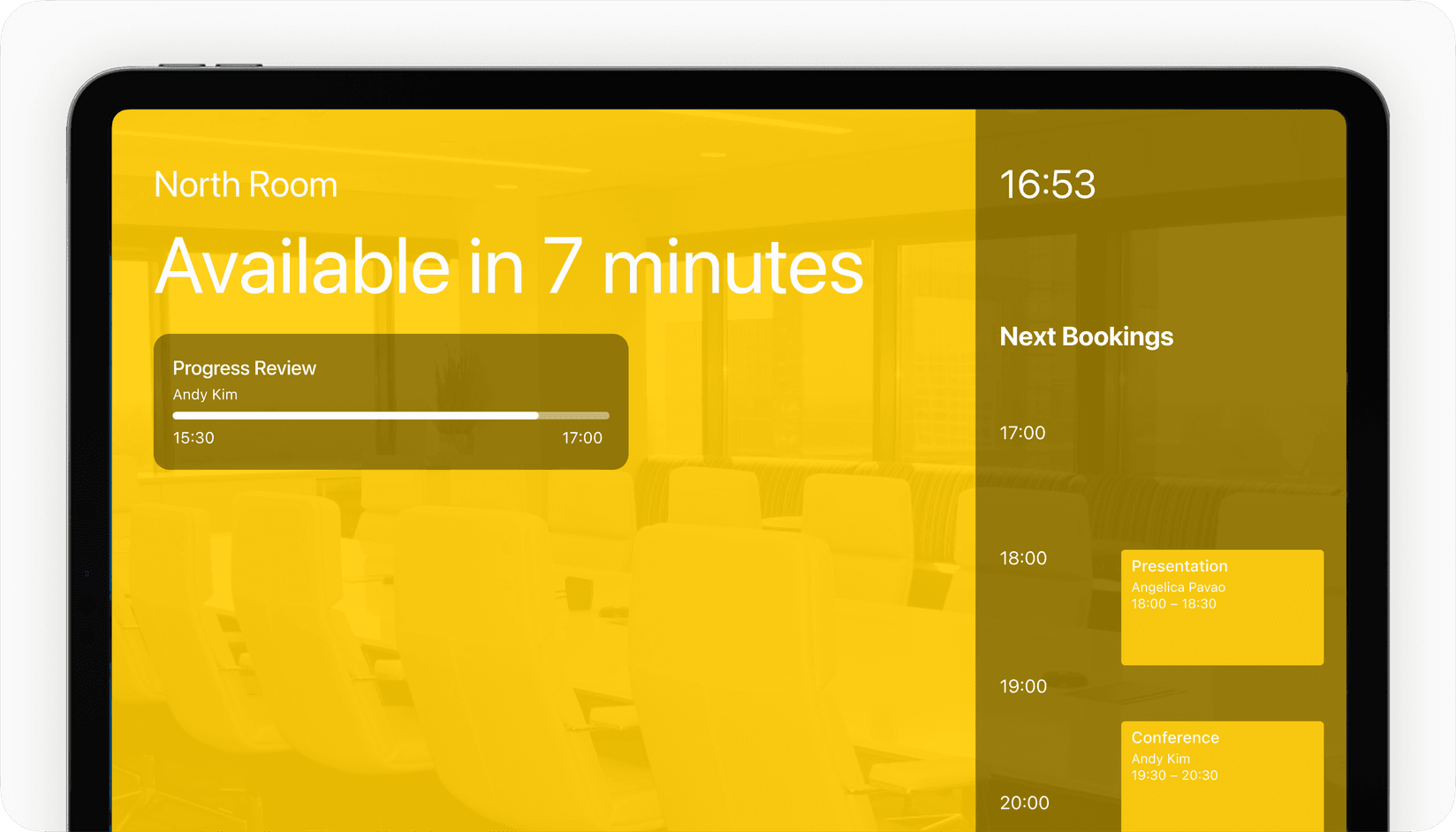
- Meeting room displays: Utilizing real-time availability screens for meeting rooms streamlines the booking process and maximizes room utilization. Members can quickly check room availability and reserve spaces, promoting efficiency and productivity.
- Smart building technology: Implementing smart building solutions, such as IoT-enabled climate control and lighting, enhances energy efficiency and creates a sustainable coworking environment.
- Mobile access control: Offering smartphone-based access control improves convenience and security. Members can easily access the space using mobile devices, ensuring a smooth entry process.
- Collaborative tools: Integrating collaborative technologies like digital whiteboards, video conferencing systems, and project management software encourages seamless collaboration among coworkers, regardless of their physical location.
- Blockchain technology: Explore blockchain for secure transactions and data management.
- VR and AR equipment: Embrace virtual reality to enhance member experiences and connectivity in the metaverse.
Generate recurring revenue and offer exceptional customer experience at your shared or coworking space
Step 7: Create Aesthetics and Promote Branding
The aesthetics and branding of a coworking space play a crucial role in creating a welcoming and memorable environment for members. Here are some tips to craft an inspiring and unique visual identity:
- Consistent branding: Create a strong, recognizable brand identity by ensuring consistent colors, fonts, and logos across all platforms, effortlessly done with a free online logo maker. This creates a strong and recognizable presence.
- Reflect on your mission: Use design elements that align with your coworking space's mission and values. Whether modern, tech-focused, or cozy and community-oriented, let your design reflect your purpose.
- Create inviting spaces: Design common areas that encourage interaction and collaboration with comfortable seating arrangements, vibrant artwork, and engaging decor.
- Personalized touches: Add personal and unique touches that set your coworking space apart, such as local artwork, custom murals, or inspiring quotes.
Importance of biophilic design
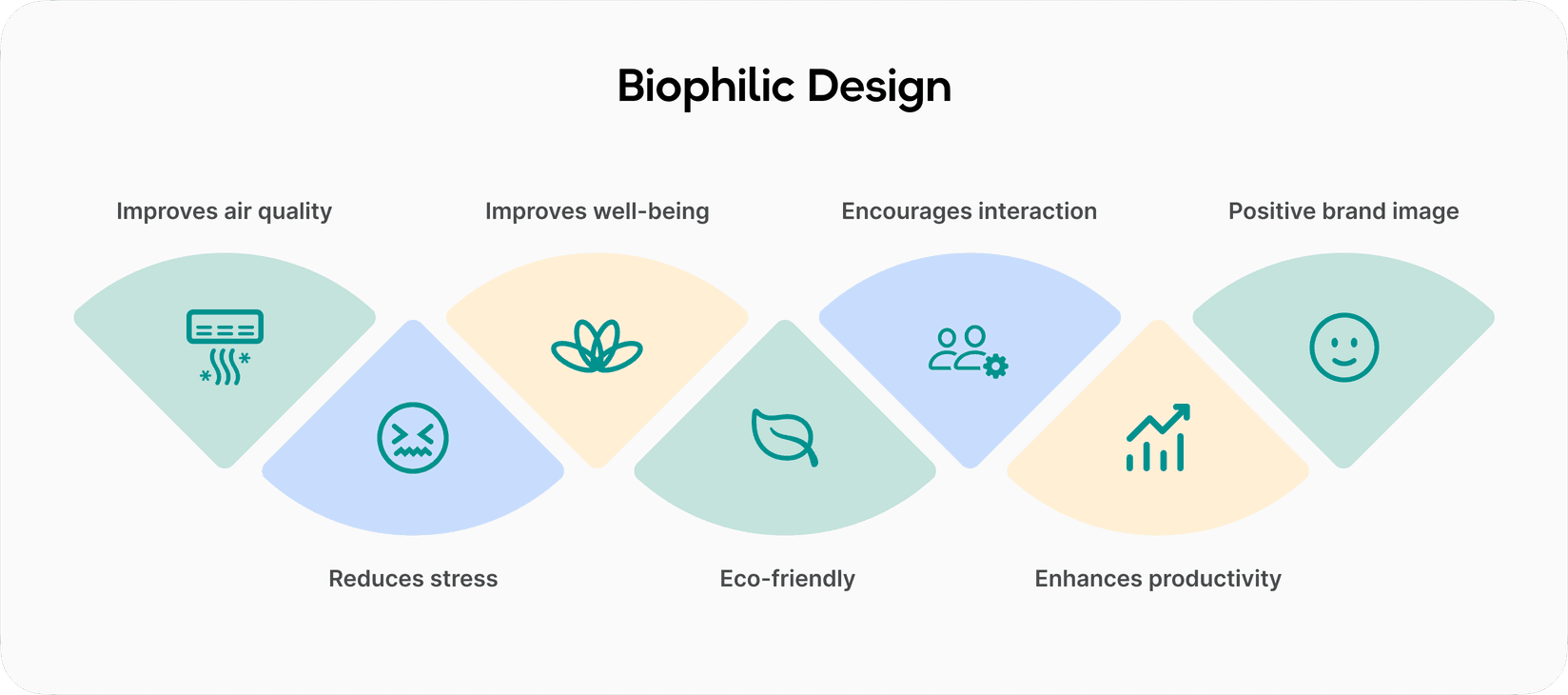
Biophilic design brings nature into the workspace, making it more soothing and nurturing. It includes elements like natural light, plants, wood, and views of nature. Incorporating biophilic design in a coworking space is essential because it:
- Boosts well-being: Connecting with nature reduces stress and makes people happier.
- Enhances productivity: Natural elements inspire creativity and focus, producing better work output.
- Reduces stress: Nature-inspired spaces create a calming atmosphere, reducing anxiety.
- Fosters connectivity: Green areas encourage interaction among coworkers, promoting collaboration.
- Improves air quality: Plants purify the air, making the workspace healthier.
- Shows sustainability: Eco-friendly design choices demonstrate environmental responsibility.
- Positive image: Biophilic design makes the space attractive and member-focused.
Step 8: Control Safety and Accessibility
Creating a safe and accessible environment is paramount in coworking spaces. Here are some guidelines to follow
Importance of safety and accessibility
- Inclusivity: Ensuring accessibility makes your space inclusive and welcoming to all, regardless of physical abilities or limitations.
- Legal requirements: Complying with accessibility standards is essential to meet legal obligations and avoid potential lawsuits.
- Member satisfaction: A safe and accessible environment enhances member satisfaction, fostering a positive reputation.
Guidelines for accessibility compliance
- ADA compliance: Adhere to the Americans with Disabilities Act (ADA) guidelines, providing accessible entrances, restrooms, and pathways.
- Clear pathways: Maintain clear, unobstructed pathways throughout the coworking space to accommodate mobility aids.
- Signage: Use clear and visible signage with readable fonts and Braille for the visually impaired.
- Elevator accessibility: Ensure elevators are accessible and equipped with audio and tactile features for those with visual impairments.
- Adjustable furniture: Offer adjustable desks and chairs to accommodate individuals of different heights and physical needs.
Emergency preparedness
- Evacuation plans: Create and communicate clear evacuation plans for different emergency scenarios.
- Emergency exits: Mark them and ensure they are easily accessible and unblocked.
- Emergency equipment: Install fire extinguishers, smoke detectors, and alarms in appropriate locations.
- First aid kits: Keep fully stocked kits readily available in easily accessible areas.
- Staff training: Train staff on emergency protocols, including assisting individuals with disabilities during evacuations.
Step 9: Make Changes to Your Design
Designing a layout that can evolve with changing needs is crucial for the success of big and small coworking spaces. Here are some tips for creating a flexible and adaptable environment:
Importance of design evolution
- Changing demands: Coworking spaces must accommodate members' evolving needs, from startups to established businesses, requiring versatile layouts.
- Future-proofing: A flexible design future-proofs the space, allowing it to adjust to new trends and technologies.
- Space optimization: Adaptable layouts optimize space usage, maximizing efficiency and member capacity.
Tips for flexible layouts
- Modular furniture: Opt for modular furniture that can be easily moved and rearranged to suit different setups and activities.
- Open spaces: Incorporate open, multi-functional areas serving as coworking zones, meeting rooms, or event spaces.
- Mobile partitions: Use movable partitions to divide larger areas into smaller private spaces or merge them for collaboration.
- Flexibility zones: Designate specific zones for different activities, such as quiet work areas, social hubs, and collaboration zones.
Role of modular furniture
- Customization: Modular furniture offers customizable configurations, adapting to individual member preferences and team needs.
- Quick reconfiguration: Easily reconfigure the layout by rearranging modular pieces, making adjustments on-the-fly.
- Space optimization: Modular furniture saves space by serving multiple functions, avoiding the need for excessive furniture.
- Cost-effectiveness: Investing in modular furniture proves cost-effective, eliminating the need to purchase entirely new setups for layout changes.
Conclusion
In this ultimate guide to designing and utilizing an effective creative coworking space layout, we've covered many factors crucial to creating a thriving coworking environment. Let's recap the key points discussed:
- Designing a coworking space involves understanding its purpose, evolution, and current trends in the industry.
- Knowing your target audience and their unique needs is essential for tailoring the layout to cater to different user types.
- Defining and designing essential rooms, such as private offices and meeting rooms, requires careful consideration of user requirements.
- Zoning and space planning help create a balanced layout with dedicated areas for collaboration, privacy, and relaxation areas.
- Incorporating ergonomic design ensures comfort, health, and productivity for coworking space users.
- Robust tech infrastructure and modern amenities, like high-speed WiFi and recreational areas, attract and retain members.
- Aesthetics and branding are vital in creating a welcoming and memorable coworking environment.
- Safety and accessibility are critical considerations for inclusivity and legal compliance.
- Creating a flexible layout with modular furniture allows the space to adapt to changing needs and trends.
We encourage you to consider these factors as you embark on your coworking space journey. Designing and utilizing an efficient coworking space layout enhances member satisfaction and fosters a thriving community of collaboration and success. So, create a coworking space that stands out and positively impacts its members' lives!
PS If you found this guide helpful, share it with others who might find it useful. We'd love to hear your thoughts and experiences. Share your tips or ask us any questions on social media. Let's build a thriving coworking community together!
FAQ
1. What's a good coworking space design?
A good coworking space design features:
- Open Layout: Spacious and open areas to promote interaction and collaboration among members.
- Flexibility: Modular furniture and movable partitions for easy reconfiguration based on changing needs.
- Private Spaces: Enclosed offices or soundproof booths for focused work and privacy.
- Ergonomic Furniture: Comfortable chairs, adjustable desks, and proper lighting for member well-being.
- Natural Light: Large windows and skylights to maximize natural light, creating a bright and energizing atmosphere.
- Modern Amenities: High-speed WiFi, meeting rooms, communal kitchen, and recreational areas for member convenience.
- Greenery: Incorporation of plants and biophilic design elements to enhance the ambiance and air quality.
- Tech Infrastructure: Reliable and secure internet access, AV equipment, and digital displays for seamless operations.
- Safety and Accessibility: Compliance with safety standards and providing accessibility for all members.
- Branding: Consistent and inspiring visual identity that reflects the coworking space's mission and values.
2. How to design a coworking space well?
To design a coworking space well:
- Understand Your Audience: Know the needs and preferences of your target members.
- Flexibility: Create a layout that can adapt to different activities and member demands.
- Balance: Provide a mix of collaborative and private spaces for varied work styles.
- Comfort: Use ergonomic furniture and ensure ample natural light and good ventilation.
- Tech-Ready: Offer reliable WiFi, AV equipment, and other tech essentials.
- Aesthetics: Create an inspiring and welcoming environment through branding and design.
- Amenities: Include modern facilities like meeting rooms, kitchen, and recreational areas.
- Safety & Accessibility: Comply with safety standards and make the space accessible to all.
- Green Spaces: Consider adding plants and biophilic elements for a refreshing ambiance.
- Member Input: Involve members in the design process to cater to their preferences.
3. What mistakes to avoid when designing a coworking space?
When designing a coworking space, avoid these mistakes:
- Overcrowding: Don't cram too many workstations. Prioritize comfort and adequate space.
- Lack of Privacy: Ensure private areas or soundproof booths are available for focused work.
- Ignoring Ergonomics: Invest in ergonomic furniture for member well-being and productivity.
- Poor Lighting: Don't skimp on natural light. It boosts mood and energy levels.
- Insufficient Tech Infrastructure: Provide reliable WiFi and tech amenities for smooth operations.
- Neglecting Safety: Comply with safety standards and implement emergency protocols.
- Lack of Flexibility: Design a layout that can adapt to changing member needs.
- Ignoring Accessibility: Ensure the space is accessible to all, following accessibility guidelines.
- Bland Aesthetics: Create an inspiring and branded space. Avoid a dull or uninspiring look.
- Forgetting Amenities: Offer essential amenities like meeting rooms, kitchen, and social areas.
4. What are examples of good coworking office space design?
Here are some coworking spaces known for their exceptional designs:
- WeWork: Renowned for its stylish and modern interiors, WeWork offers creative spaces that inspire collaboration.
- The Wing: A women-focused coworking space with chic and aesthetically pleasing design elements.
- Huckletree: Known for its unique and vibrant spaces, Huckletree creates an atmosphere that sparks creativity.
- NeueHouse: Offers sophisticated and luxurious coworking spaces tailored for creative professionals.
- Covo: A design-forward coworking space with thoughtful details, providing a welcoming environment.
- The Commons: Known for its warm and inviting interiors, The Commons promotes a sense of community.
- Second Home: Combines nature-inspired design with innovative architecture for a refreshing workspace.
- Spaces: Offers modern and dynamic spaces that encourage collaboration and networking.
- Hub Australia: Known for its trendy and functional spaces that cater to diverse working styles.
- Impact Hub: A global network of coworking spaces with unique and socially-conscious designs.
Keep Reading

Spacebring Joins the Fun at CWSC24

Innovation Junction: a Guide to Makerspaces in Coworking Environments

Commissary Kitchens: Expand Your Coworking Offerings

